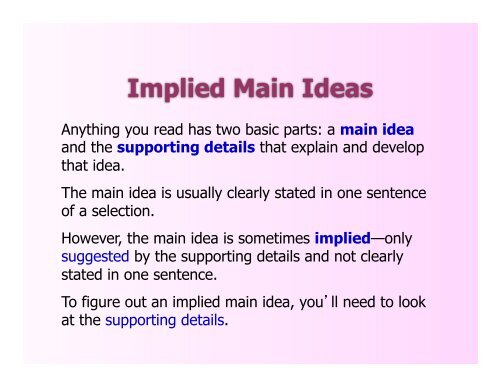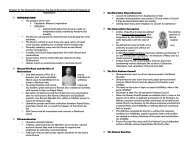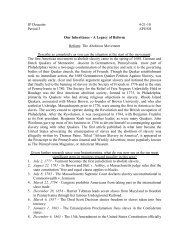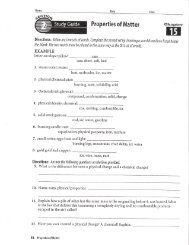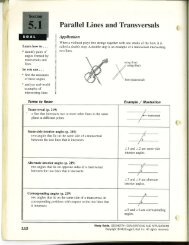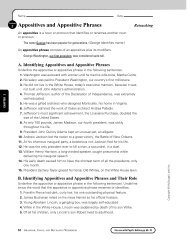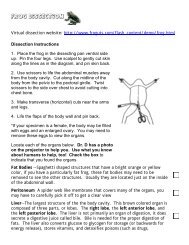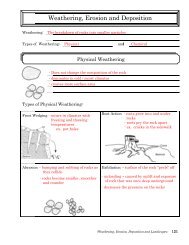Implied Main Ideas
Implied Main Ideas
Implied Main Ideas
Create successful ePaper yourself
Turn your PDF publications into a flip-book with our unique Google optimized e-Paper software.
What is the implied main idea<br />
of the cartoon?<br />
Copyright 1997 by Randy Glasbergen. www.glasbergen.com
You can figure out the implied main idea<br />
by looking at the supporting details:<br />
1. The man’s coworkers are complaining<br />
that he doesn’t leave coffee for anyone<br />
else.<br />
2. He has such a caffeine high that he is<br />
flying!<br />
The clearly implied idea is that he is drinking<br />
too much coffee.<br />
HERMAN: © Jim Unger/Dist. By Newspaper Enterprise Association. Inc.
Read the following paragraph and see if you can figure out its<br />
main idea.<br />
! !<br />
All people are concerned about a few great questions: the existence of God, the purpose<br />
of life, the existence of an afterlife, and morality. About the first, science has nothing to say:<br />
no test tube has either proved or disproved God’s existence. As to the purpose of life, although<br />
science can provide a definition of life and describe the characteristics of living organisms,<br />
it has nothing to say about ultimate purpose. Regarding an afterlife, science can offer no<br />
information, for it has no tests that it can use to detect a “hereafter.” As for the question of<br />
morality, science can demonstrate the consequences of behavior but not the moral superiority<br />
of one action compared with another. Science cannot even prove that loving your family and<br />
neighbor is superior to hurting and killing them.<br />
The above paragraph has no good “umbrella” statement that covers all the<br />
other sentences. To decide on the main idea, we must ask the same three<br />
questions we’ve already used to find main ideas:<br />
• Who or what is this paragraph about? (The answer is the topic<br />
of the paragraph.)<br />
• What is the main point the author is trying to make about that topic?<br />
• Does all or most of the material in the paragraph support this main idea?
All people are concerned about a few great questions: the existence of God, the purpose of life, the<br />
existence of an afterlife, and morality. About the first, science has nothing to say: no test tube has either<br />
proved or disproved God’s existence. As to the purpose of life, although science can provide a definition of<br />
!<br />
life and describe the characteristics of living organisms, it has nothing to say about ultimate purpose.<br />
Regarding an afterlife, science can offer no information, for it has no tests that it can use to detect a<br />
“hereafter.” As for the question of morality, science can demonstrate the consequences of behavior but not<br />
the moral superiority of one action compared with another. Science cannot even prove that loving your<br />
family and neighbor is superior to hurting and killing them.<br />
• Who or what is this paragraph about?<br />
In the paragraph, all the details are about science and great human<br />
concerns, so that must be the topic.<br />
• What is the main point the author is trying to make about that topic?<br />
Science alone cannot tell us about the four main concerns that all people<br />
have.<br />
• Does all or most of the material in the paragraph support this main<br />
idea?<br />
Yes. Every sentence is about the “great questions” people are concerned<br />
about and the lack of information science provides about them.
What inferences can<br />
you make about this<br />
cartoon?<br />
Find the two inferences<br />
that are most logically<br />
based on the<br />
information it suggests.<br />
A. The couple is not likely to have a good dining experience<br />
at the restaurant.<br />
B. The couple will never eat at the restaurant.<br />
C. The restaurant was recently closed for health violations.<br />
D. Whoever is running the restaurant is not doing a good job.<br />
REAL LIFE ADVENTURES © 2006 GarLanco, Reprinted with permission of UNIVERSAL PRESS SYNDICATE. All rights reserved.
Check Your Understanding II<br />
Read the following passage and find the three inferences<br />
that can most logically be drawn from it.<br />
A famous psychology experiment conducted by Dr. John B. Watson demonstrates<br />
that people, like animals, can be conditioned—trained to respond in a particular way to<br />
certain stimulations. Watson gave an eleven-month-old baby named Albert a soft, furry<br />
white rat. Each time Albert tried to stroke the rat, Dr. Watson hit a metal bar with a<br />
hammer. Before long, Albert was afraid not only of white rats but also of white rabbits,<br />
white dogs, and white fur coats. He even screamed at the sight of a Santa Claus mask.<br />
A. Dr. Watson did not like small children.<br />
B. Before the experiment, Albert was not afraid of white rats.<br />
C. Albert had been familiar with rats before the experiment.<br />
D. If he had seen a black fur coat, Albert would have screamed.<br />
E. Albert connected the loud noise of the hammer striking the<br />
metal bar with the white rat.<br />
F. Albert was afraid of unexpected loud noises.
Reading a Graph<br />
Changes in U.S. Work Force, 1900–2010<br />
Can you find the three inferences that<br />
are most logically based on the graph to<br />
the left?<br />
1. The work force of 1900 was very<br />
different from the work force of today.<br />
2. Before 1900, farmers made up the<br />
smallest percentage of workers.<br />
3. In 1940, the percentages of farm<br />
workers and white-collar workers were<br />
about equal.<br />
4. In general, as the number of farming<br />
and blue-collar workers has decreased,<br />
the number of white-collar workers has<br />
increased.<br />
5. In 1940, blue-collar workers made up<br />
about 25 percent of the U.S. work force.<br />
6. In the future, most U.S. workers are<br />
likely to be white-collar workers.
The three logical inferences are …<br />
1. The workforce of 1900 was very different<br />
from the workforce of today.<br />
4. In general, as the number of farming and<br />
blue-collar workers has decreased, the<br />
number of white-collar workers has<br />
increased.<br />
6. In the future, most U.S. workers are<br />
likely to be white-collar workers.


